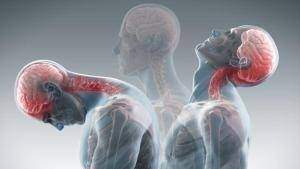
Whiplash Injury – Symptoms and Treatment
Whiplash is a type of neck pain that results from an injury that occurs following a sudden acceleration-deceleration force or movement of the head backwards, forwards, or sideways. The movement is unrestrained, rapid and abrupt, often due to a car accident or any other mishaps. Hence, the force causes the head into forward-flexion (head-down position) and the head gets whipped back very quickly into extension (head in a looking up position).
Aside from road traffic accidents, the following reasons can also cause whiplash:
- being struck on the head by a solid or heavy object
- the head is suddenly jolted backwards due to a slip or fall
- a sudden blow to the head, such as during sports like rugby or boxing

When this occurs, the forces may result in injuries to bony or soft tissues such as in the neck muscles, disc, tendons, ligaments, and nerve roots.
Several Grades of Whiplash Severity
There are several grades to the severity of whiplash-associated disorders (WAD).
- Grade 0: No physical signs of injury. No pain or discomfort.
- Grade 1: No physical signs of injury. Neck pain, tenderness or stiffness.
- Grade 2: Neck pain, stiffness or tenderness. Some physical signs of injury such as point of tenderness or trouble turning the head.
- Grade 3: Pain, tenderness or stiffness and neurological signs of injury, such as changes to the reflexes or weakness experienced in the arms.
- Grade 4: Pain, fracture or dislocation of the neck.
The above grading is also known as the Quebec Classification Disorder and is used as the guideline by the Singapore courts to assess neck injuries.
What are whiplash symptoms?
Because the soft tissues in the neck become stretched and strained, a number of symptoms can also occur following whiplash injury. Symptoms after the initial trauma can occur immediately after the injury or even after a few days. Additionally, do note that whiplash can also occur at relatively low-speed crashes.
People who experience whiplash may develop one or more of the following symptoms which include:
- Headache
- Pain in the shoulders and arms
- Dizziness
- Altered sensation, pins and needles, numbness in the arms
- Weakness
- Visual and auditory symptoms
- Difficulty concentrating
- Difficulty in swallowing
Less common symptoms include dizziness, memory loss, pins and needles in your arms and hands, poor concentration and irritability. The symptoms are usually worse the day after the injury and may continue to worse for the next several days. People experiencing such symptoms should seek proper medical advice as soon as possible, within 24 hours if possible.
Why is your neck so stiff and it hurts to move?
In most cases of mild or Grade 1 or 2 whiplashes, the muscles attached to the neck joints (cervical spinal vertebrae) are strained and suffer some form of bruising. In anticipation of the shock (from the oncoming accident or fall), the muscles of the neck will tense up to support the neck and head before being forcibly stretched by the force of the accident. The force will exceed these muscles’ ability to support and will cause a strain.
It is these sprained muscles that hurt when you later move your head as they very much involved the movement of the head and neck.
Stiffness comes on later as a result of a lack of movement to avoid the pain. This is a form of pain avoidance. Stiffness is often the result of neck joints losing their mobility from the lack of movement and the muscles that become tight and taut as a result of being held in place for long periods of time. The stiffness later makes it hard to move without pain in a vicious circle.
Physiotherapy Options
Treatment options for whiplash with physiotherapy include mobilisation, manipulation and exercises. Most whiplash patients will start to feel better within a few weeks of treatment. Needless to say, the sooner you start your treatment and follow the treatment plan, the shorter your recovery period will be. Putting off treatment will often lead to chronic issues setting in and making it that much harder and longer to recover.
- Reduce neck pain, headaches and inflammation.
- Improve the range of motion of your neck joints (see manual therapy and joint mobilisation)
- Improve your neck posture through neck position awareness (proprioception), fine motor control and balance.
- Lengthen tight-and-shorten muscles by releasing taut and tense muscles.
- Strengthen your neck and upper back (thoracic spine) muscles.
Located in Singapore, our team of physiotherapists at Core Concepts can aid in your road to recovery by effectively resolving your injury with treatment options tailored to your individual condition. With actively guided treatment, you can expect to recover with reduced neck pain, improved neck posture and minimising your chances of future neck pain.
Related Articles
- Whiplash - Signs, Symptoms and Treatment (Part I) In this article, we will be looking at the three most commonly asked questions and areas about whiplash: What is…
- Chronic Low Back Pain: Bio-Psycho-Social Model In… Low back pain is termed chronic when the pain lasts for more than 3 months. The literature and clinical practice…
- Quick Fixes for Common Cycling Pain and Injuries The physical and mental health benefits of cycling every day is undeniable – and of course, we can’t ignore that…
- Whiplash Associated Disorders: A Review of… The number of road accidents in Singapore has grown steadily in the last few years. A total of 14,995 road…
- Common Cycling Injuries in Singapore: What They Are… Cycling is a fantastic sport and offers a plethora of benefits. Unfortunately, it can also result in a number of…
